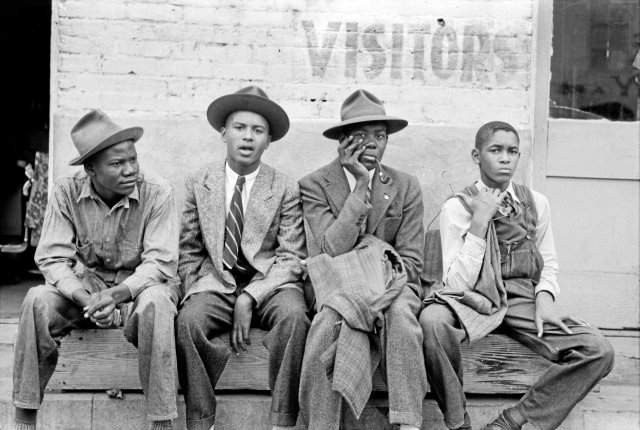Can and will the Communist Party USA help black people – or will they help the party see clearly?
Foto: imago/glasshouseimages
This novel is from 1943. It is called “The People from Heaven” and boils down to an almost late-Western duel scene in which Eli Bishop, the devilish seducer of the All-American small town of Warrensburg, threatens to triumph. Before that, he repeatedly poured out his racist poison until the residents were so contaminated and morally lost that they did his bidding – almost. “This used to be a white man’s town,” Bishop ends his last monologue, “and it won’t be long before it’s completely white again.”
The “Indian”, the “nigger woman”, “the Indian’s half-breed boy” and of course the “son of a Jew” are supposed to leave the city in a procession of shame, that is his will, but then of all people, the black woman, who is given the descriptive name America Smith, puts an end to this ghost. With brute force, which the intellectuals, especially the preacher and the doctor, could not bring themselves to do before.
If there’s one thing that can be criticized about John Sanford’s “The People from Heaven,” it’s that it has a clear bias. No wonder, Sanford was a member of the Communist Party of the USA (CPUSA), although not very doctrinaire. He was bored with Marxist theory, he was simply on the side of the underprivileged, the outcast and the lost – what other party should you belong to? The CPUSA, however, tried to prevent the book because they feared that it would at best cause unrest in the Black community, and that such a partial revolt would inevitably be doomed to failure. After all, the party trusted him to have a lot of impact.
In fact, “The People from Heaven” is an agitprop novel of the first order. Sanford wants to prove through literature that America’s centuries-long history of conquest, oppression and exploitation has by no means come to an end. The associated chauvinistic and racist attitudes have become so deeply ingrained in people’s unquestioned everyday knowledge that their potential for violence can be mobilized again at any time.
Remarkably, the somewhat too obvious suggestion of what the reader should think and think only marginally detracts from the literary quality of this novel. Sanford has much more to offer both linguistically and narratively. “The People from Heaven” is told broadly; Sanford calls up an extensive arsenal of characters and lets his protagonists act in short, dialogue-rich scenes. His year-long work as a screenwriter in Hollywood seems to have an impact on the structure of the novel. But the form also has its aesthetic necessity. In this way he can illuminate the sociotope from the inside, so to speak.
When people talk to each other, they show who they are as spiritual children. And so, from many little anecdotes, implied scandals, gossip and rumors, a very vivid picture of an average small town in the Adirondack Mountains, New York, is formed.
So the story takes place in the northeast, and that also makes sense: it’s not confederate ex-slave owners who allow themselves to be seduced here, but northerners. The old man Little Johnny Littlejohn, who is as odd as he is principled, has to be surprised when his carer tells him that “the city” wants the “nigger woman” to disappear. »Half a glass of warm milk hit the nurse in the face. ‘For God’s sake!’ said the old man. ‘I said the South has this war lost!‹.«
Sanford contrasts the loosely connected small town scenes with episodes from violent US history, which he reinterprets with biting sarcasm and which also differ stylistically through their bound language. He once again traces the discovery of America by Columbus, which is where the title comes from. The indigenous people see their prophecies fulfilled and consider the strangers to be “people from heaven”. But soon they ask themselves the question: “If these really are people from heaven, / why do they know so damn well about hell?”
This hell is paraphrased by other narrative poems about the slave transports or the burning of Salem witches. The complaint culminates in the disillusioned monologue of the chief’s daughter Pokahontas. “Why, my people, why haven’t we destroyed them?” As is well known, she herself helped them gain a foothold and is now despairing of it.
This linguistically varied novel collage demands a little more attention from the reader than the usual 300-page page-turner of the season, but Sanford pays it back in several ways. The many gaps and omissions in the text create a pull because, like in a detective novel, you look for the clues to fill them in. This novel is quite exciting precisely because of its experimental form. But above all, he impresses with his formal sovereignty and versatility, with which Sanford blends back and forth between the different stylistic registers. He imagines the hateful invectives of a dyed-in-the-wool racist just as plausibly as the rhetorically clever argument, reminiscent of a classic drama, of the intellectuals who know that they should actually do something against the demagogue Eli Bishop, but are just talking again.
In between, the author always adds little descriptive details that make it clear why he couldn’t be happy in Hollywood. “When the door opened, the wind came in, and with the wind came the cold spring rain. The smoke in the air was twisted into bales like hay, and the shadow of a swinging hanging lamp swung syncopated from wall to wall. And then the door was closed and the damp wind was shut out, and as the smoke expanded, the lamp slowly dimmed and came to rest. Drops of water ran down the woman’s coat, clung to the fibers of the hem for a moment, glittered and fell to the floor. This is how Sanford announces the appearance of his protagonist America Smith. This is not only an expressive representation of the moment that is convincing in its imagery, but also a symbolically encrypted foreshadowing of what the plot has yet to tell. In the end it is tears and blood that trickle down. “The People from Heaven” is one of those not-so-common trend works that are also completely aesthetically convincing.
John Sanford died in 2003. He was born Julian Shapiro in New York in 1904 and, as a Jew, changed his name in the 1930s at the behest of his writer friend and mentor Nathaniel West in order not to let the subcutaneous anti-Semitism in the publishing world ruin his career. He knew exactly what he was talking about, even if the “son of a Jew” was to be driven out of the city.
John Sanford: The People from Heaven. Translated from the American by Jochen Stremmel. With an afterword by Jack Mearns. Edition Tiamat, 280 pages, br., 30 €.
Subscribe to the “nd”

Being left is complicated.
We keep track!
With our digital promotional subscription you can read all issues of »nd« digitally (nd.App or nd.Epaper) for little money at home or on the go.
Subscribe now!
sbobet judi bola sbobet judi bola online
